Design Details
Concrete: Solid Versatility
Story by Mark Greenawalt,©December, 2006
Originally published in Contact Magazine , (December
2006) Concrete is the foundation of nearly every architectural structure and typically hidden from sight by everything from carpet and linoleum to marble and wood flooring. A handful of artisans are seeing to it, however, that this age-old building material will once again have its day in the sun within modern architecture. More architects and interior designers are specifying concrete for countertops, fireplace mantles and bathtubs, instead of the more traditional marble, granite, tile, laminate or stainless steel. Concrete may not have the polished luster of these alternatives, but it can cost more and definitely weighs more. Why it is having resurgence in urban and high-end residential architecture is due to versatility.
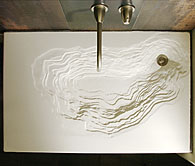 Concrete can be molded into a wide variety of shapes, limited only by the inherent properties of the material and the designer’s imagination. Kitchen and Bath Business Magazine recently named California designer Fu-Tung Cheng one of the top 50 most influential figures in the bath and kitchen industry over the past 50 years, noting he has made concrete a “highbrow, high-end phenomenon.” Cheng’s showcase portfolio highlights everything from strictly rectangular bathroom vanities to gently curving kitchen islands reminiscent of ocean liners. Cheng has penned three books that share his innovative techniques and provide insight into the materials and tools required for do-it-yourself enthusiasts. These books celebrate the wonderful possibilities of concrete design while instilling the importance of the limitations of the material. Because of its weight and internal strength, molds of concrete are limited in length to avoid cracking from expansion, as well as breaking during shipping and installation. Expansion joints are therefore implemented in designs that exceed eight feet in length. Concrete can be molded into a wide variety of shapes, limited only by the inherent properties of the material and the designer’s imagination. Kitchen and Bath Business Magazine recently named California designer Fu-Tung Cheng one of the top 50 most influential figures in the bath and kitchen industry over the past 50 years, noting he has made concrete a “highbrow, high-end phenomenon.” Cheng’s showcase portfolio highlights everything from strictly rectangular bathroom vanities to gently curving kitchen islands reminiscent of ocean liners. Cheng has penned three books that share his innovative techniques and provide insight into the materials and tools required for do-it-yourself enthusiasts. These books celebrate the wonderful possibilities of concrete design while instilling the importance of the limitations of the material. Because of its weight and internal strength, molds of concrete are limited in length to avoid cracking from expansion, as well as breaking during shipping and installation. Expansion joints are therefore implemented in designs that exceed eight feet in length.
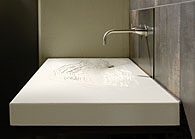 Another more versatile element of concrete over other rival building materials is color. Concrete can be mixed with a rainbow of color pigments in much the same way house paints are mixed. The majority of end users, however, select a limited palette of colors that mimic the look of popular stones. Dave Crawford, of the Scottsdale-based Concrete Interior Design, Inc., offers 12 standard colors, but can color match the concrete to the client’s decor or sample. He says, “There may be some variation from the sample to the finished product, as this is the nature of the product, but your choices are unlimited.” Concrete artisans are able to incorporate patterns of color in separate concrete pours divided by expansion joints or installed at graduated elevations. They can even include amorphous shapes of color within a single pour. Another more versatile element of concrete over other rival building materials is color. Concrete can be mixed with a rainbow of color pigments in much the same way house paints are mixed. The majority of end users, however, select a limited palette of colors that mimic the look of popular stones. Dave Crawford, of the Scottsdale-based Concrete Interior Design, Inc., offers 12 standard colors, but can color match the concrete to the client’s decor or sample. He says, “There may be some variation from the sample to the finished product, as this is the nature of the product, but your choices are unlimited.” Concrete artisans are able to incorporate patterns of color in separate concrete pours divided by expansion joints or installed at graduated elevations. They can even include amorphous shapes of color within a single pour.
The color of concrete design elements are further enhanced by the addition of aggregates, metals, sands and a multitude of other unique substrates incorporated into the concrete pour. Concrete Interior Design, recently completed a commercial project for an architectural firm’s headquarters that featured cantilevered concrete desks that were poured with shards of quartz, creating a luminous surface. Crawford explains, “We use diamond buffers to grind the concrete surface to reveal the embedded aggregates and then continue to polish the surface to a lustrous sheen.” Concrete Interior Design has several showrooms throughout the Phoenix area that have project samples, including embedded metallic fibers, shells and colorful glass shards. “We have some truly creative processes for transforming the look of the concrete,” says Crawford. “Everything from acid washes, to give the look of leather, to patinas, to give a weathered, Old World look.”
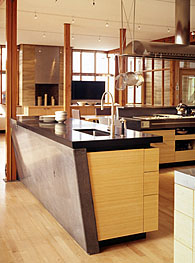 It is important to note that this level of concrete design is not based on the cast-in-place techniques that are used to create sidewalks and back porches. These counters are poured in extremely smooth-surfaced molds made of laminated particleboards and precisely contoured Styrofoam. These smooth-bottom surfaces ensure the top layer of concrete is plum and even. Meticulous detail is used so the molds are level during the pour, the concrete is sufficiently vibrated to remove air bubbles, and any aggregates become properly seated within the mold. The designers mentioned above claim to have their own special formulas to improve the nominal strength of the concrete and to provide their concrete with the optimum stain resistance and sealing properties. Gore Design Co. takes prides in using recycled materials in its proprietary mixture called Recycrete. “From utilizing industrial by-products, such as fly-ash, to incorporating reclaimed materials, using heavy-metal-free pigments and voc-free sealers, Gore Design Co. continues to set the benchmark of sustainable design excellence.” It is important to note that this level of concrete design is not based on the cast-in-place techniques that are used to create sidewalks and back porches. These counters are poured in extremely smooth-surfaced molds made of laminated particleboards and precisely contoured Styrofoam. These smooth-bottom surfaces ensure the top layer of concrete is plum and even. Meticulous detail is used so the molds are level during the pour, the concrete is sufficiently vibrated to remove air bubbles, and any aggregates become properly seated within the mold. The designers mentioned above claim to have their own special formulas to improve the nominal strength of the concrete and to provide their concrete with the optimum stain resistance and sealing properties. Gore Design Co. takes prides in using recycled materials in its proprietary mixture called Recycrete. “From utilizing industrial by-products, such as fly-ash, to incorporating reclaimed materials, using heavy-metal-free pigments and voc-free sealers, Gore Design Co. continues to set the benchmark of sustainable design excellence.”
Costs for concrete heavily depend on the complexity of the project, the colors involved and the hands-on requirements of measuring the space and components. Concrete Revolution, a design firm in Denver, Colorado, states that typical costs can range from $80 to $124 per square foot, and time frames can be as much as eight to ten weeks from template to installation. The heavy weight of concrete has been considered a downside, but typical kitchen and bath cabinetry can handle this weight without the need of additional supports.
If you hadn’t considered concrete for your next project, visit a showroom of one of the specialized designers of this art form and see if this exciting new use of a classic building material is right for you.
This article can also be found
on-line at http://www.contact-mag.com/issue5/details.htm
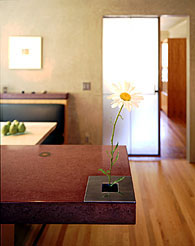
Mark Greenawalt
http://www.futureclassx.com

|
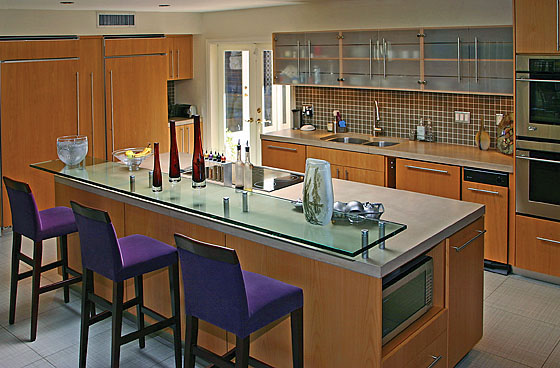
 Concrete can be molded into a wide variety of shapes, limited only by the inherent properties of the material and the designer’s imagination. Kitchen and Bath Business Magazine recently named California designer Fu-Tung Cheng one of the top 50 most influential figures in the bath and kitchen industry over the past 50 years, noting he has made concrete a “highbrow, high-end phenomenon.” Cheng’s showcase portfolio highlights everything from strictly rectangular bathroom vanities to gently curving kitchen islands reminiscent of ocean liners. Cheng has penned three books that share his innovative techniques and provide insight into the materials and tools required for do-it-yourself enthusiasts. These books celebrate the wonderful possibilities of concrete design while instilling the importance of the limitations of the material. Because of its weight and internal strength, molds of concrete are limited in length to avoid cracking from expansion, as well as breaking during shipping and installation. Expansion joints are therefore implemented in designs that exceed eight feet in length.
Concrete can be molded into a wide variety of shapes, limited only by the inherent properties of the material and the designer’s imagination. Kitchen and Bath Business Magazine recently named California designer Fu-Tung Cheng one of the top 50 most influential figures in the bath and kitchen industry over the past 50 years, noting he has made concrete a “highbrow, high-end phenomenon.” Cheng’s showcase portfolio highlights everything from strictly rectangular bathroom vanities to gently curving kitchen islands reminiscent of ocean liners. Cheng has penned three books that share his innovative techniques and provide insight into the materials and tools required for do-it-yourself enthusiasts. These books celebrate the wonderful possibilities of concrete design while instilling the importance of the limitations of the material. Because of its weight and internal strength, molds of concrete are limited in length to avoid cracking from expansion, as well as breaking during shipping and installation. Expansion joints are therefore implemented in designs that exceed eight feet in length. Another more versatile element of concrete over other rival building materials is color. Concrete can be mixed with a rainbow of color pigments in much the same way house paints are mixed. The majority of end users, however, select a limited palette of colors that mimic the look of popular stones. Dave Crawford, of the Scottsdale-based Concrete Interior Design, Inc., offers 12 standard colors, but can color match the concrete to the client’s decor or sample. He says, “There may be some variation from the sample to the finished product, as this is the nature of the product, but your choices are unlimited.” Concrete artisans are able to incorporate patterns of color in separate concrete pours divided by expansion joints or installed at graduated elevations. They can even include amorphous shapes of color within a single pour.
Another more versatile element of concrete over other rival building materials is color. Concrete can be mixed with a rainbow of color pigments in much the same way house paints are mixed. The majority of end users, however, select a limited palette of colors that mimic the look of popular stones. Dave Crawford, of the Scottsdale-based Concrete Interior Design, Inc., offers 12 standard colors, but can color match the concrete to the client’s decor or sample. He says, “There may be some variation from the sample to the finished product, as this is the nature of the product, but your choices are unlimited.” Concrete artisans are able to incorporate patterns of color in separate concrete pours divided by expansion joints or installed at graduated elevations. They can even include amorphous shapes of color within a single pour.

